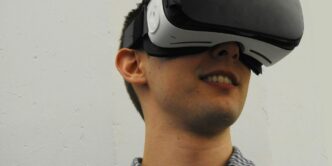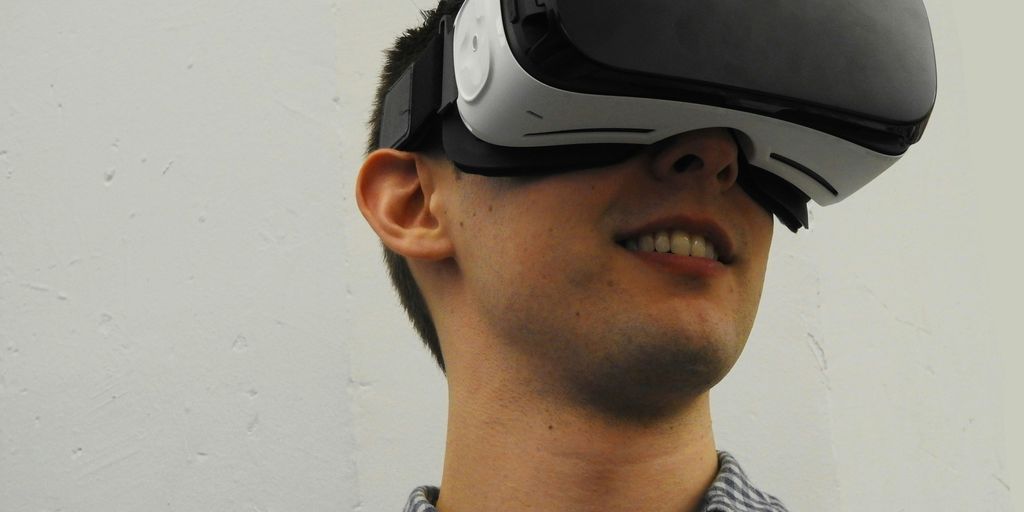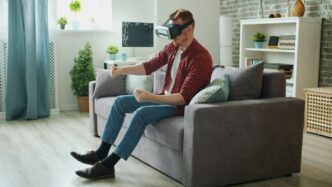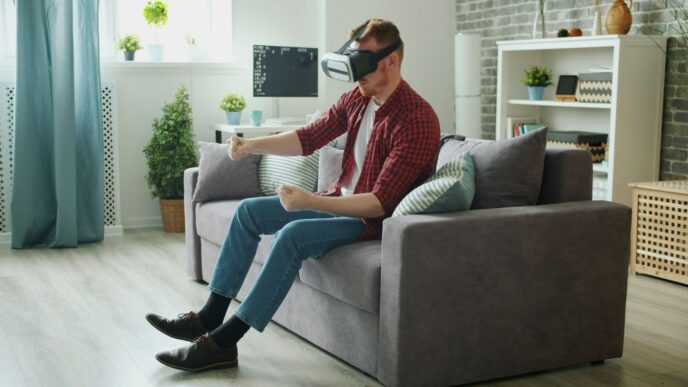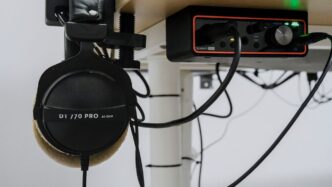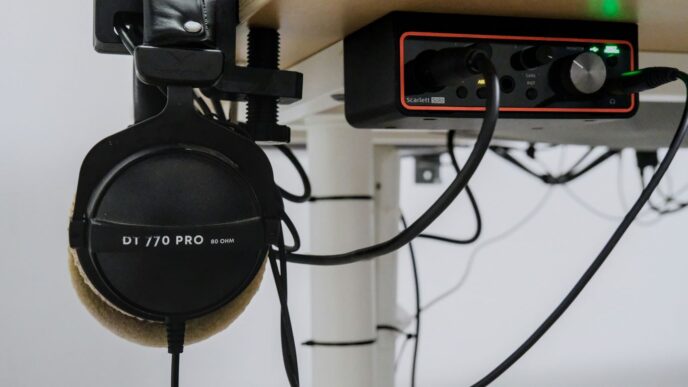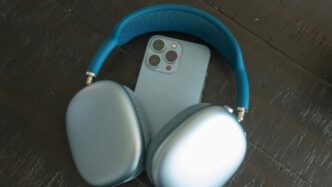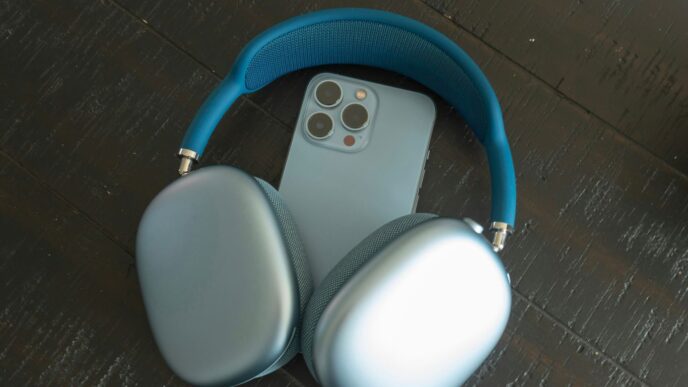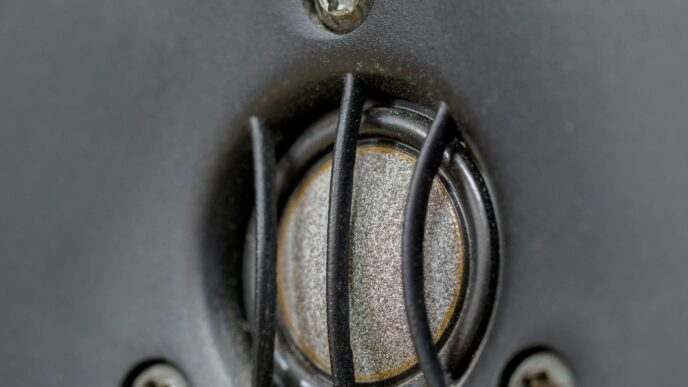So, you’re trying to figure out the differences between the Quest 3 and the new Quest 3S, huh? It can be a bit confusing with all the similar names. We’re going to break down what really sets these two VR headsets apart, looking at everything from how clear the picture is to how comfortable they feel on your head. If you’re wondering which one is the better buy for your money, stick around. We’ll help you sort out the quest 3 vs 3s.
Key Takeaways
- The Quest 3S uses Fresnel lenses and has the same display resolution as the Quest 2, meaning visuals won’t be as sharp or clear as the Quest 3’s pancake lenses and higher-res screen.
- Both headsets share the same processor, so game performance and load times should be very similar, with the 3S potentially being a bit quicker in some cases.
- Hand tracking and general passthrough quality are comparable between the Quest 3 and 3S, though the Quest 3 offers a wider field of view and better clarity in mixed reality.
- While the Quest 3S has a smaller battery, Meta estimates slightly longer usage times per charge compared to the Quest 3, though demanding games will drain both quickly.
- Most Quest 3 accessories, like head straps and controller grips, are compatible with the Quest 3S, but specific items like facial interfaces and lens inserts might not work between the two.
Quest 3 vs Quest 3S: Visual Fidelity and Immersion
When you’re looking at VR headsets, the visuals are a pretty big deal, right? It’s what pulls you into the game or experience. So, how do the Quest 3 and the Quest 3S stack up in this department?
Display Resolution and Pixel Density
Let’s get down to the nitty-gritty. The Quest 3 actually has a higher resolution per eye than the Quest 3S. We’re talking 2,064 x 2,208 pixels per eye for the Quest 3, while the Quest 3S sticks with the Quest 2’s resolution of 1,832 x 1,920 pixels per eye. What does this mean for you? Well, the Quest 3 should offer slightly sharper text and more detailed graphics. It’s not a massive jump, but if you’re someone who really notices these things, the Quest 3 has a bit of an edge. For many, though, the Quest 3S display is still pretty good, especially if you’re coming from a Quest 2.
Lens Technology: Pancake vs. Fresnel
This is where things get interesting. The Quest 3 uses what are called ‘pancake’ lenses. These are flatter and allow the headset itself to be thinner and lighter. They also tend to offer a clearer image across a wider area, meaning less of that ‘sweet spot’ blurriness you might get at the edges with older lens types. The Quest 3S, on the other hand, uses the same ‘Fresnel’ lenses as the Quest 2. These are the more traditional, ribbed lenses. While they work fine, they can sometimes feel a bit more bulky and might have that noticeable blurriness if you look too far to the side. The pancake lenses on the Quest 3 really do make a difference in overall visual clarity.
Field of View Comparison
Field of View, or FoV, is basically how much you can see around you in the virtual world. Think of it like looking through binoculars versus looking with your own eyes. The Quest 3 offers a wider field of view, around 110 degrees. The Quest 3S, however, has a narrower field of view, similar to the Quest 2, at about 90 degrees. That extra bit of FoV on the Quest 3 can make the experience feel more immersive and less like you’re looking through a screen. For some, that 90-degree view on the Quest 3S might feel a little constricting, especially if they’re used to wider views. It’s a subtle difference, but it can impact how ‘in’ the game you feel. If you’re looking for the most expansive view, the Quest 3 is the way to go, but the Quest 3S still provides a solid VR experience for many users.
Performance and Internal Hardware
When you’re looking at the Quest 3S versus the Quest 3, the performance side of things is actually pretty similar, which is good news if you’re coming from a Quest 2. Both headsets use the same Snapdragon XR2 Gen 2 chip and have 8GB of RAM. Meta says this setup should give you about double the GPU power compared to the older Quest 2, meaning faster loading times and generally smoother gameplay. This boost is what allows for some of the newer, more demanding games and graphical upgrades that just weren’t possible before.
Shared Processing Power and Memory
As mentioned, both the Quest 3 and the Quest 3S are equipped with the Snapdragon XR2 Gen 2 processor and 8GB of RAM. This means that for most applications and games, you’re going to see a very similar performance level. This shared hardware is a big reason why many games that came out for the Quest 3 are also available on the Quest 3S, often with graphical enhancements. Think of it like having the same engine in two different car models; one might have a slightly different body, but the core power is the same.
Load Times and Game Performance
While the core hardware is the same, you might notice slight differences in how quickly games load or how smoothly they run, especially in titles that push the limits. Games that were designed with the Quest 3’s upgraded visuals in mind can take advantage of the XR2 Gen 2 chip. For example, loading up a big game like Asgard’s Wrath II showed the Quest 3S to be a bit quicker than the Quest 2, but the Quest 3’s better display optics really make those graphical upgrades pop more. It’s a bit like playing a great game on an older TV – the game is good, but the display holds it back a little. Still, for the price, the Quest 3S is a solid performer. You can even connect it to your PC to play games from platforms like Steam VR, which is a nice bonus.
Future Software Support
Because both headsets share the same core processing power, they are both well-positioned for future software updates and new game releases. Meta has been pushing out updates that improve mixed reality performance, making those experiences use less power and run better. Many upcoming titles, especially those that heavily utilize mixed reality or require more graphical grunt, are being developed with the Quest 3 and Quest 3S in mind. This means that if you buy either headset, you should have a good runway for new content. Some games, like Batman: Arkham Shadow, are even exclusive to the Quest 3 and 3S, showing that Meta is building out its library for this generation of hardware. If you’re looking for a headset that will last you a while with new games, the Quest 3S offers a lot of value, especially considering its storage options.
Mixed Reality Capabilities and Tracking

The Quest 3S really steps up its game when it comes to blending the real world with virtual elements. It’s pretty neat how it can overlay digital stuff onto your actual surroundings. This means you can play games where virtual characters pop up in your living room, or follow workout routines with holographic trainers right in front of you. It makes everything feel more present, you know?
Passthrough Quality and Clarity
One of the big upgrades from older models is how clear the passthrough is. The Quest 3S uses color cameras, which is a huge leap from the grainy black-and-white views of the Quest 2. You can actually see your environment well enough to read a text message on your phone or find your way around the office without taking the headset off. While they might not be quite as sharp as the Quest 3’s, they’re definitely good enough for most things. This improved color passthrough is key to making mixed reality feel useful and not just a gimmick.
Hand Tracking Accuracy
Forget controllers if you want! The Quest 3S works with hand tracking, and it’s gotten much better. You can use your hands to interact with menus, play certain games, or just navigate the system. It feels more natural than fumbling with controllers sometimes, especially for quick interactions. It’s still not perfect for every single game, but for general use, it’s quite impressive how well it picks up your movements. It’s a big step up from what we saw on the Quest 2, making controller-free experiences much more viable. You can check out some of the latest advancements in VR hand tracking.
Low-Light Performance Enhancements
When you’re in dimmer rooms, tracking can sometimes get a bit shaky. The Quest 3S has made some improvements here, but it’s still an area where performance can dip. If you’re trying to play a game or use an app in a dimly lit space, you might notice the tracking isn’t as solid as it is in a well-lit room. This is something to keep in mind if your primary play space isn’t very bright. Generally, more light means better tracking for both your headset and your hands.
Design, Comfort, and Ergonomics
When you’re strapping on a VR headset for hours, comfort really matters, right? Both the Quest 3 and the Quest 3S have some design choices that affect how they feel on your head.
Physical Design and Weight Distribution
Let’s talk about how these things are built. The Quest 3 is actually a bit slimmer than the Quest 3S, mostly because it uses pancake lenses. This makes the Quest 3 feel a little less front-heavy. The Quest 3S, with its older Fresnel lenses, is a bit thicker. Honestly, both headsets weigh about the same, around 515 grams, so it’s not a huge difference in raw weight. But that slight difference in thickness can make the Quest 3 feel a bit more balanced. The Quest 3 is the recommended choice for mixed reality headsets due to its streamlined design and improved comfort, making it ideal for extended use.
Interpupillary Distance (IPD) Adjustment
Getting the distance between your eyes right is key for a clear picture and avoiding headaches. The Quest 3 has a more precise way to adjust the IPD, meaning you can fine-tune it to match your eyes better. The Quest 3S has a standard adjustment, which is fine, but it might not be as exact for everyone. This can make a difference in how sharp the image looks, especially if your eyes are spaced a bit differently than average.
Head Strap Comfort and Alternatives
Out of the box, both headsets come with a basic cloth strap. It’s okay for short sessions, but many people find it doesn’t distribute weight very well. You might feel like it’s resting on your ears or just not secure enough. Because of this, most users end up looking for an upgrade. The good news is that many accessories designed for the Quest 3, like the popular Elite Strap, will also work with the Quest 3S. So, while the default strap might not be the best for long playtimes, there are plenty of options to make either headset more comfortable.
Battery Life and Power Management

When it comes to keeping your VR adventures going, both the Quest 3 and the Quest 3S have some similar, yet distinct, power stories. Neither headset is going to win awards for marathon battery life, but there are some differences to consider.
Battery Capacity Differences
The Quest 3 packs a slightly larger battery, coming in at 5,060 mAh. The Quest 3S, on the other hand, has a 4,324 mAh battery. On paper, you might think the Quest 3 would last significantly longer, but it’s not quite that simple.
Real-World Usage Estimates
Meta officially states that the Quest 3S should get about 2.5 hours of use on a full charge. The Quest 3 is listed at around 2.2 hours. In our testing, we found these numbers to be pretty close to reality for general use. However, don’t expect to get those full times if you’re really pushing the headset with demanding games or applications. For more intense experiences, you might see that battery life drop closer to the two-hour mark for both devices.
Impact of Demanding Applications
It’s pretty much a given that running graphically intensive games or using the mixed reality features heavily will drain the battery faster. The powerful Snapdragon XR2 chip and 8GB of RAM in both headsets are power-hungry components. So, if you’re planning a long session of something like Batman: Arkham Shadow, be prepared to plug in sooner rather than later. It seems like the Quest 3S, despite its smaller battery, manages to eke out a little more time in some scenarios, possibly due to optimizations or slightly less demanding default settings compared to the Quest 3’s higher-resolution display. Ultimately, for extended play, a battery pack or frequent charging breaks are likely in your future with either headset.
Audio and Connectivity Options
When it comes to audio and how you connect your gear, both the Quest 3 and the Quest 3S have some things to consider. It’s not a huge difference, but it might matter depending on what you’re looking for.
Headphone Jack Availability
This is actually a pretty big point for some people. The Quest 3 has a standard 3.5mm headphone jack. This means you can plug in pretty much any headphones you already own, which is great if you have a favorite pair or want to use something with better sound quality than built-in options. The Quest 3S, however, does not have this jack. You’ll need to rely on Bluetooth headphones or speakers if you want to use external audio. This makes the Quest 3 more flexible for users who prioritize their own audio setups.
Integrated Spatial Audio
Both headsets do come with built-in speakers that provide spatial audio. This means the sound seems to come from different directions, making games and experiences more immersive. It’s pretty neat how the sound can feel like it’s all around you, even without headphones. The quality is decent on both, but if you’re really picky about audio, you’ll probably want to use your own headphones with the Quest 3.
USB-C Port Functionality
Both the Quest 3 and Quest 3S use a USB-C port. This is your main connection for charging, obviously, but it’s also used for data transfer and connecting to a PC. You can use it to play PC VR games or even stream games from services like Xbox Cloud Gaming. The cable included is usually a charging and data cable, so it’s pretty versatile. It’s good to know that this core functionality remains the same across both models, so you won’t be missing out on PC connectivity if you opt for the more affordable Quest 3S.
Storage and Accessory Ecosystem
When you’re looking at the Quest 3S, storage and what you can do with accessories are pretty important things to consider. It’s not just about the headset itself, but what you can add to it and how much stuff you can actually keep on it.
Internal Storage Options
The Quest 3S comes in two flavors when it comes to how much you can store directly on the device. You can get it with either 128 GB or 256 GB. Now, 128 GB might sound like a lot, but VR games can get pretty big. Some titles, like that big RPG that came out last year, can easily eat up over 30 GB. So, if you plan on downloading a bunch of games and apps, that 128 GB could fill up faster than you think. The 256 GB version is probably the safer bet if you don’t want to constantly worry about deleting things. There’s no way to add more storage later, like with an SD card, so you have to pick the right amount when you buy it.
Accessory Compatibility
This is where things get interesting. A lot of the accessories made for the Quest 3 will actually work with the Quest 3S too. That’s good news because it means you’ve got a pretty decent selection already available. Think about things like:
- Comfort Straps: The strap that comes with the headset isn’t the most comfortable for everyone. Many people end up buying an ‘Elite Strap’ or similar to get a better fit and balance. Most Quest 3 straps should fit the 3S.
- Controller Grips and Straps: To make sure you don’t accidentally throw your controllers, extra straps are a good idea. Grips can also make them feel better in your hand.
- Link Cables: If you want to connect your Quest 3S to a PC to play PC VR games, you’ll need a good USB-C cable.
- Cases: Keeping your headset protected when you’re not using it is smart, and there are plenty of cases designed for the Quest 3 that should work fine for the 3S.
However, there are a few things that won’t transfer over. Specifically, things that fit directly onto the lenses, like prescription lens inserts or certain facial interfaces, are usually designed for the exact dimensions of a specific headset model. So, you’ll need to make sure any of those types of accessories are explicitly listed as compatible with the Quest 3S.
Lens Inserts and Prescription Needs
If you wear glasses, you know the struggle of trying to fit them inside a VR headset. It can be uncomfortable, and sometimes they don’t fit at all. Both the Quest 3 and the Quest 3S come with a glasses spacer that gives you a bit more room. But for the best experience, many people opt for custom prescription lens inserts. These clip right onto the headset’s lenses, meaning you don’t have to wear your glasses at all. While many Quest 3 inserts should work with the Quest 3S, it’s always best to double-check the compatibility list from the manufacturer before buying, just to be absolutely sure you’re getting something that will fit perfectly.
So, Which Quest is Right for You?
Alright, so we’ve gone over the nitty-gritty of the Quest 3 and the new Quest 3S. Honestly, if you’re coming from a Quest 2 and just want a solid upgrade without breaking the bank, the Quest 3S is a really good pick. It handles games well, the mixed reality stuff is pretty neat, and it’s a step up. But if you’ve got the extra cash and really want that top-tier visual experience, the Quest 3 with its better lenses and sharper display is still the one to beat. Think about what you’ll be using it for most – casual gaming, serious immersion, or maybe some work – and that should help you decide which headset fits your budget and your VR needs best.
Frequently Asked Questions
How does the Quest 3S screen compare to the Quest 3?
The Quest 3S has the same screen resolution and lenses as the older Quest 2. This means the picture won’t be as sharp or clear as the Quest 3, which has better lenses and a higher resolution screen. Think of it like watching a movie on an older TV versus a brand new one.
Will games run differently on the Quest 3S compared to the Quest 3?
Both headsets use the same powerful chip and have the same amount of memory, so they can run all the same games and apps. This means games should load and play about the same on both devices. They will also get software updates for the same amount of time.
Is the Quest 3S better for mixed reality in the dark?
The Quest 3S is actually better in low light for tracking your hands and controllers because it has special lights called IR illuminators. The Quest 3 doesn’t have these. However, the Quest 3’s overall mixed-reality experience looks clearer because its screen is sharper and its viewing area is wider.
Which headset has better battery life?
While the Quest 3S has a slightly smaller battery, it’s estimated to last about 18 minutes longer than the Quest 3. In real use, both headsets drain battery pretty fast, usually lasting around two hours. For longer sessions, you might need an extra battery pack for either headset.
Can I still plug in headphones with the Quest 3S?
The Quest 3S is missing the headphone jack that the Quest 3 has. You’ll need to use headphones that connect through the USB-C port or use wireless headphones. The USB-C port is now on the left side of the headset.
Will my Quest 3 accessories work with the Quest 3S?
Yes, most accessories made for the Quest 3 will also work with the Quest 3S. This includes things like comfort straps, controller straps, cases, and charging cables. However, you might need special face covers or lens inserts if you wear glasses, as the Quest 3S is a bit thicker.

